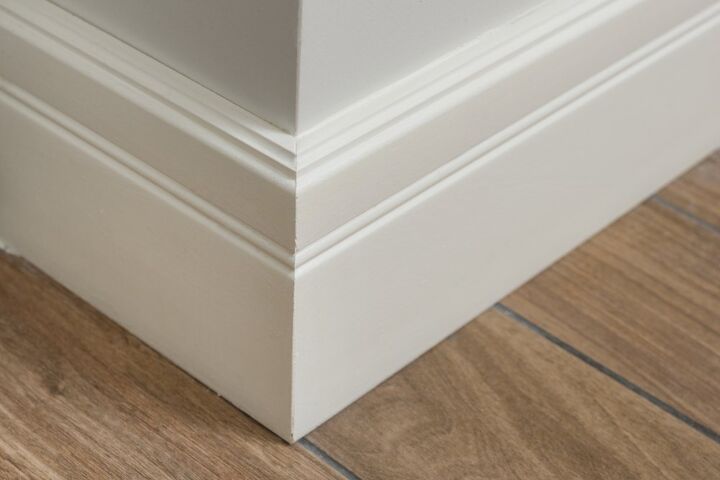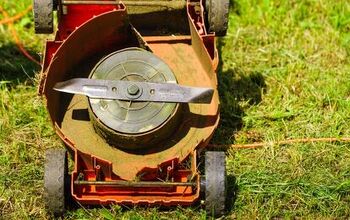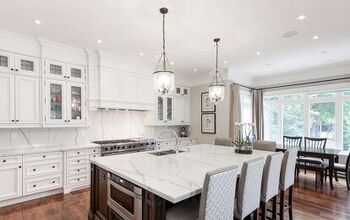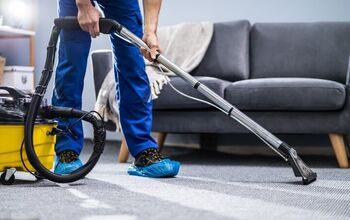5 Types Of Shoe Molding (With Photos)

Shoe molding can effectively close the gap between a floor and the wall. It may not seem necessary at first, but it is important to take care of it before the gap becomes larger. Considering how important shoe molding is, what are the main types that you should be aware of?
Medium Density Fiberboard, PVC, and wood are the best types of shoe molding. Polystyrene and vinyl are common materials for shoe molding, but they are less durable. Install nails at a downward angle to secure shoe molding in place and use caulk if there is still a gap.
Shoe molding is also a stylistic choice that can help tie the room together. Whether you match your shoe molding to the wall and trim or create a contrast, shoe molding can be aesthetically pleasing.
Do You Need Interior Trim or Decorative Molding Installation?
Get free, zero-commitment quotes from pro contractors near you.

Shoe Molding Types
Shoe molding is an often overlooked part of walls and flooring, but it is important. Gaps between the bottom of a wall and the floor can cause big problems later, and you must fix them right away. Let’s take a close look at the types of shoe molding and see how they differ from one another.
1. Medium Density Fiberboard
Medium Density Fiberboard, also known as MDF, is a popular form of shoe molding because it is durable. It is made out of sawdust that is effectively bonded together with resin to make it strong. You won’t have to worry about damaging MDF, and it can withstand bumps, scratches, and foot traffic.
The main drawback to Medium Density Fiberboard is that it is unappealing to look at it. Luckily, homeowners can stain or paint MDF to give it a more desirable look which helps during resale. MDF generally comes in a quarter-round shape that protects the bottom of the wall where it meets the floor.
Installing MDF shoe molding is one of the best ways to close a gap between the baseboard and floor. Consider Medium Density Fiberboard if you want an option that you won’t have to repair or replace with wood.
2. PVC
You get the best of both worlds between affordability and function when it comes to PVC shoe molding. PVC is a great choice for builder-owners and DIYers alike because it is cheap and easy to install on your own. You can install PVC shoe molding with a miter saw, nails, a coping saw, and adhesive.
Unlike similar materials such as polystyrene, you are unlikely to bend and damage PVC shoe molding. PVC can withstand knocks, tears, and foot traffic that would otherwise be harmful to other materials. The cheapest way to install PVC shoe molding is to measure and cut lengths, then fasten them with a finish nailer.
Many homeowners choose PVC because you can paint or stain it to make it look more like natural wood. That means that you won’t have to sacrifice affordability for visual a great look.
3. Wood
Most homeowners picture wood when they think of shoe molding materials, and with good reason. Wood is an ideal material because it is durable, long-lasting, and you can stain or paint it. Common varieties of wood used in shoe molding include oak, pine, and walnut.
You can tie the room together if you paint or stain your wood shoe molding to match your trim and walls. Alternatively, homeowners use shoe molding and trim to contrast the walls and flooring in your home. Shoe molding is generally thin, but you can find thick wood shoe molding that can withstand foot traffic more easily.
Make sure that it is okay to paint your wood shoe molding before you prime it. Some finished and pre-painted wood shoe moldings are not suitable to paint, but it is generally okay to paint pine molding.
4. Vinyl
Vinyl shoe molding is cheap and easy to install, but it lacks the durability of wood or PVC. Luckily, you can paint or stain vinyl to match or contrast your trim. You can easily cut and install vinyl shoe molding the same way that you would with PVC at roughly the same cost.
You can walk past, bump, or knock into vinyl shoe molding without worrying about damage. Granted, you may distress the stain or paint job if you aren’t careful when you peruse the halls or move furniture. Consider vinyl if you want shoe molding that is equally affordable as it is visually appealing.
5. Polystyrene
Homeowners often choose polystyrene shoe molding to save money on installation costs. The benefits essentially stop there, because polystyrene isn’t a great way to protect your walls. It is possible to paint polystyrene shoe molding, but the paint can easily flake due to weathering and foot traffic.
Polystyrene is not the ideal material if you live in a family home where people walk around often. It is easy to scrape, bend, or break sections of polystyrene with little effort. However, it is the cheapest material that you can choose for shoe molding, and that is why it is common in many homes.
Shoe Molding vs. Quarter Round
It is difficult for many homeowners to choose between shoe molding and quarter round molding. The choice between the two can be tricky based on practical and personal aesthetic reasons. With that said, both quart round and shoe molding serve distinct purposes that are ideal for unique situations.
Shoe molding is considered more versatile than quarter round because it serves more purposes. However, quarter round is unique to situations with specific types of gaps between the floor and wall. Let’s take a look at the difference between the two and see why it’s important to choose the right one.
Quarter Round
Quarte round is similar to shoe molding, but it sits at a 90-degree angle. The size and shape of quarter round molding make it perfect for gaps that are 90 degrees. You can easily nail quart round molding in place around corners, and that makes them easy to install throughout an entire house.
With that said, quarter round molding is not generally the primary choice for builders and carpenters. That is because it not as universally useful as something like shoe molding which is typically an easy fit. Even still, quarter round molding can be a lifesaver if you have a 90-degree gap.
Shoe Molding
Shoe molding is a base shoe similar to a quarter round that has no requirements as far as the angle of the gap. Similar to crown molding, shoe molding is a way to tie into the aesthetic of the room and the rest of your home. You have countless options when it comes to staining and painting wood, PVC, and vinyl shoe molding.
Many homeowners take advantage of shoe molding as a way to compliment or contrast the room’s color palette. Shoe molding is often more flexible than quarter round molding, and that makes it less susceptible to bending and warping.
Which is Better?
Quarter round molding is better if you have a 90-degree gap between the floor and wall. However, shoe molding is more versatile and better for just about any other situation. You have the same options when it comes to materials, stains, paint, and finishes between the two.
With that said, shoe molding is generally better because it is more universally useful. Choose quarter round molding if it is a perfect fit for your specific gap. Otherwise, consider shoe molding because it is durable, versatile, and can cover potentially dangerous gaps.
Related Questions
Is shoe molding necessary?
Shoe molding is necessary if you have an uneven subfloor that creates unappealing gaps. Install shoe molding to close the gap between the bottom of your wall and the floor. Otherwise, this gap can worsen over time and fall victim to water damage and pests such as termites.
Does shoe molding need to be caulked?
You don’t need to caulk shoe molding if you nail it to base molding so that it is secure. Caulking shoe molding can ensure a better seal and is helpful if you use materials like polystyrene. You may also need to caulk shoe molding if the gap between the floor and wall becomes bigger.
Do You Need Interior Trim or Decorative Molding Installation?
Get free, zero-commitment quotes from pro contractors near you.

Summing It Up
Wood and PVC are the best kinds of shoe molding because of their durability and visual appeal. You can stain or paint PVC shoe molding to look more like wood, and it is cheap to do so. Polystyrene and PVC are affordable options, but they provide less durability and visual flair than wood or vinyl.
Medium Density Fiberboard, or MDF, is a great option because it can hold up to damage. It is hard to damage MDF or even chip the paint with heavy foot traffic. Shoe molding is worth the time and money because it seels potentially harmful gaps in your walls and flooring.
Related Articles

Nick Durante is a professional writer with a primary focus on home improvement. When he is not writing about home improvement or taking on projects around the house, he likes to read and create art. He is always looking towards the newest trends in home improvement.
More by Nick Durante


















![10 Best Zero Turn Mowers – [2022 Reviews & Ultimate Buyer's Guide]](https://cdn-fastly.upgradedhome.com/media/2023/07/31/9070522/10-best-zero-turn-mowers-2022-reviews-ultimate-buyer-s-guide.jpg?size=350x220)












